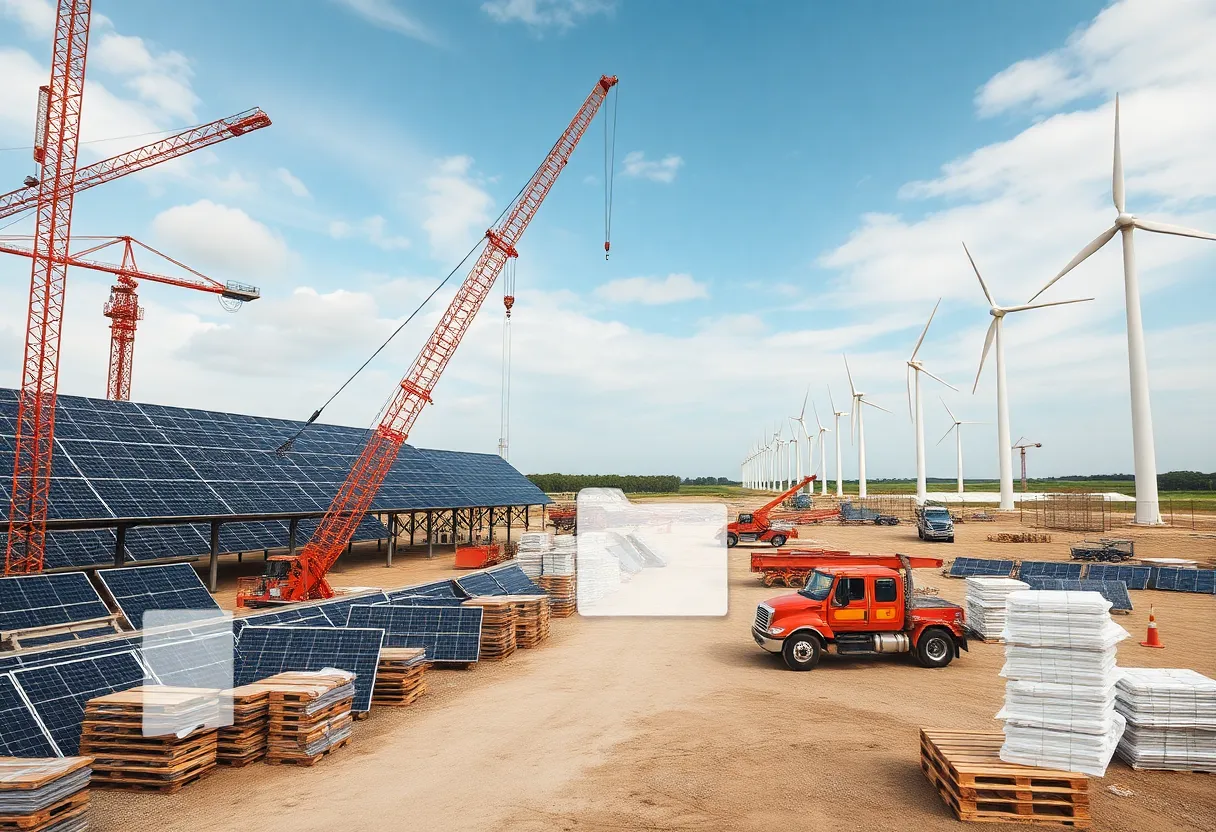United States, August 15, 2025
News Summary
Crayhill Capital has introduced a Tax Equity Bridge Lending programme offering facilities from $50 million to $500 million to help U.S. renewable developers meet tightened federal tax-credit qualification rules. The product pairs short-term bridge loans against anticipated tax-equity commitments with pre-construction and construction financing, preferred-equity step-up support, and equipment procurement assistance. Designed to accelerate meaningful construction activity while permanent tax-equity and construction financing are finalized, the programme aims to bridge timing gaps caused by stricter documentation and construction tests and to help developers secure long-lead components and close construction financing more quickly.
Crayhill Capital launches Tax Equity Bridge Lending programme to help US renewables meet 2026–2027 tax-credit deadlines
A new lending programme aimed at moving solar, wind and battery projects quickly through pre-construction and into full construction has been launched. The facility, sized between $50m–$500m, combines tax equity bridge lending with development and construction financing to help U.S. renewable developers meet tightened federal tax-credit qualification dates in 2026 and 2027.
Key facts up front
- Programme type: Tax Equity Bridge Lending (TEBL) offering blended pre-construction, construction equity and preferred-equity step-up capital.
- Facility sizes: From $50 million to $500 million.
- Primary aim: Enable developers to start and sustain substantial construction activities and close construction financing while monetizing federal tax credits.
- Deadline context: New rules require projects to either begin construction by 4 July 2026 or be placed in service by 31 December 2027 to qualify for federal investment and production tax credits.
What the programme does
The new TEBL solution provides capital against future tax equity commitments. It is structured to give developers capital for pre-construction activities, construction equity injections and a preferred-equity buffer that steps up as projects progress. The package also offers assistance with critical equipment procurement, which can shorten procurement timelines and reduce the risk of supplier delays.
By advancing pre-construction capital and bridging to tax-equity closings, the facility aims to create a clearer, faster path for projects to meet the qualifying rules and to secure construction financing on competitive terms.
Why the timing matters
Regulators have set strict start and in-service deadlines tied to tax credits, and additional executive guidance may require projects to show a “substantial portion” of physical construction rather than relying on preliminary site work and permitting. Those tighter standards add pressure on timelines and create a need for immediate, sizeable capital during the pre-construction phase.
Market conditions cited alongside these regulatory shifts include rising electricity demand driven in part by rapid growth in data-center and AI-related load. Developers that cannot move quickly risk losing eligibility for federal tax incentives that help make projects financeable.
How the lending is structured
The TEBL programme is asset-focused and built to accept tax-equity commitments as the primary source of repayment when projects reach the tax-equity close. The structure typically combines:
- Pre-construction loans secured against future tax equity.
- Construction equity to cover build costs until permanent financings are finalized.
- Preferred-equity step-ups to shore up sponsor liquidity through construction.
- Procurement support for long-lead equipment such as PV modules, inverters and battery systems.
Developer benefits and intended outcomes
The programme is designed so developers can initiate substantial construction quickly, reduce schedule risk, and present a clear financing path to tax-equity investors and construction lenders. The combined capital aims to limit the number of financing partners needed, compress closing timelines, and improve the chance that projects will meet federal tax-credit eligibility windows.
Sponsor background and track record
The firm launching the programme has publicly stated it has deployed more than $4 billion across more than 50 transactions since 2015 and manages a multi‑billion dollar alternative asset business focused on asset-based finance in energy and related sectors. A recent flagship fund closed with about $1.31 billion of capital commitments and included committed co-investment capacity. The firm describes its platform as focused on providing flexible, speed-oriented capital to developers.
Related transactions and partnerships
The firm’s prior transactions include a multi-year financing relationship with a developer that provided roughly $275 million of flexible capital to advance projects into construction and scale a solar and energy storage platform. That relationship supported a large pipeline of PV and co-located storage projects and planned deployment targets measured in gigawatts of clean capacity.
Market context and implications
The new lending option arrives amid broadly heightened demand for rapid project delivery. Developers face compressed timetables to meet tax-credit qualification windows that are tied to very specific start and in-service dates. The availability of larger bridge facilities that can support both development and construction phases may reduce execution risk and help move more projects to construction before the deadlines.
If broadly adopted, similar blended bridge solutions could ease immediate capital shortages and cut the number of transactions developers must manage to take projects from permitting to full operation. For investors and lenders, these structures create an opportunity to align near-term credit against the expected inflows from tax-equity closes while capturing construction upside.
Bottom line
The programme is a targeted, asset-backed response to an industry under time pressure. By pairing pre-construction and construction capital with procurement support and explicit alignment to future tax-equity, the facility seeks to give developers a faster, clearer route to qualify projects under the new federal timelines.
Frequently asked questions
What is a Tax Equity Bridge Loan?
A Tax Equity Bridge Loan is short- to medium-term financing that allows developers to build a project and cover costs until a tax-equity investor closes. Repayment typically comes from the tax-equity proceeds once the investor commits capital to the project.
Who can use this type of programme?
Developers of utility-scale solar, wind and battery projects that expect to monetize investment or production tax credits and need capital to begin or scale construction can benefit from this structure.
How does the facility help with tax-credit deadlines?
By providing pre-construction and construction capital, and by supporting procurement of long-lead equipment, the facility helps projects reach the level of physical work needed to satisfy regulatory standards for having “begun construction” or for being placed in service by the relevant dates.
What size transactions are supported?
Available facility sizes range from $50 million up to $500 million, intended for larger utility-scale developments or aggregated portfolios.
Does this replace tax equity?
No. The bridge product is designed to be repaid by or converted into permanent tax-equity and construction financing when those sources become available.
Key features at a glance
| Feature | Details |
|---|---|
| Programme name | Tax Equity Bridge Lending (TEBL) programme |
| Facility size | $50m–$500m |
| Target projects | Utility-scale solar, wind and battery projects in pre-construction or early construction |
| Primary uses | Pre-construction capital, construction equity, preferred-equity step-up, equipment procurement support |
| Repayment source | Future tax-equity commitments and construction/permanent financings |
| Regulatory deadlines addressed | Begin construction by 4 July 2026 or placed in service by 31 December 2027 for federal tax credits |
| Historical deployment | Firm has deployed more than $4 billion across 50+ transactions since 2015; recent fund closed at about $1.31bn |
Deeper Dive: News & Info About This Topic
Additional Resources
- Alternative Credit Investor: Crayhill Capital launches finance solution for US green energy projects
- Wikipedia: Tax Equity Bridge Lending
- IREI: Crayhill Capital Management closes third flagship fund with more than $1.3B
- Google Search: Crayhill Capital Management third flagship fund 1.31 billion
- PR Newswire: Crayhill provides $200M secured receivables financing facility to Stenn Technologies
- Google Scholar: Crayhill Stenn receivables financing 200 million
- PR Newswire: Urban Grid closes $275M debt refinance provided by Crayhill Capital Management
- Encyclopedia Britannica: Urban Grid debt refinance Crayhill
- ION Analytics / Mergermarket: Carlos Mendez on trends in SRT
- Google News: Carlos Mendez Crayhill SRT synthetic risk transfer





